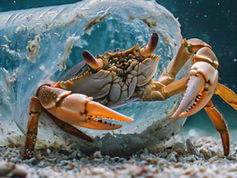Healing the Ozone Layer
- Lauren A. Moe

- Feb 15, 2023
- 4 min read
Updated: Jul 7, 2023
If you were around 35 years ago, then you were a part of history watching the world come together to protect the ozone layer with the Montreal Protocol. So, what exactly is the ozone layer? How did over thirty countries agree on banning synthetic chemicals, and what does that mean for us in this lifetime?
The ozone layer is one layer of Earth’s atmosphere that, like a sponge, is responsible for absorbing bits of radiation from the sun. While radiation typically has a negative connotation, not all radiation is bad. Our world exists in a careful balance of short wave radiation reaching Earth from the sun, and long wave radiation being emitted back into the atmosphere from Earth (discussed a bit here). The wavelengths contain energy which heat the world around us and allow life to flourish. The ozone layer acts as Earth’s sunscreen and protects us from some of the more harmful ultraviolet (UV) radiation which can harm cells, cause skin cancer, and damage DNA molecules in plants and animals. If you go to the beach all day without sunscreen, your skin burns, right? This is due to the UV radiation that does reach us. The ozone layer absorbs 98% of UV light, so you can imagine the concern from scientists when they saw the ozone layer thinning.
In the early 1900’s, refrigerators were made with toxic chemicals that could cause fatal accidents if leaked. In 1928, new chemicals called CFCs (shorthand for chlorofluorocarbons) were discovered and branded as a safer, non-toxic alternative. CFCs were used in production of solvents, packing materials like foams, aerosol sprays, and refrigerators starting in 1932, and by the 1950’s, they were added to air conditioning units for homes, offices, and cars. However, by the 1970’s, scientists noticed the ozone layer was being depleted much quicker than expected.
As CFCs are produced and spread through the space we live in, winds mix the air and elements up into the atmosphere. Once CFCs reach high altitudes, the compound is able to break down. The first chemical named in CFCs is chlorine, an element essential in keeping the oceans salty, seasoning food, cleaning pools, and much more. In the ozone layer however, chlorine is a bad influence; it’s the devil sitting on ozone’s shoulder. Ozone is made up of three oxygen molecules combined in a perfect group. When carbon joins the party, it convinces the band to break apart and leave the other oxygens. The new group oxygen forms is no longer considered ozone, meaning it is unable to shield the Earth from UV radiation like it used to. Scientists saw this reaction as a quickly growing hole in the ozone layer (nearly 9 million square miles in size) forming over Antarctica.
Something had to be done to fix the hole; if it grew much larger, the entire planet would be at risk. In 1987, the Montreal Protocol was signed by over 30 countries which would phase out the use of ozone depleting substances (ODSs), primarily CFCs. This showed a global effort to protect our environment from man-made disasters, something many environmentalists could only have dreamed of. It has since been amended to phase out hydrofluorocarbons (HFCs), which were used as a replacement for some ODSs, but eventually proved to be just as detrimental. Thanks to the Montreal Protocol, the UN Environmental Program has announced that the ozone layer has begun healing itself, and the hole over Antarctica is expected to close by the 2060’s. The graph below displays the ODSs emissions from 1961 to 2014, which shows the remarkable decrease responsible for the healing ozone layer. Scientists have also stated that the efforts of ozone protection have slowed climate change by keeping an estimated 135 billion tons of carbon dioxide from entering the environment between 1990 and 2010 alone.







Comments